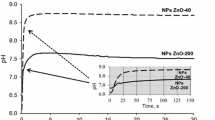Abstract
We have evaluated the particle sizes, zeta potentials and hydrodynamic radii of zinc oxide (ZnO) nanoparticles in various aqueous conditions such as deionized water, phosphate buffered saline and Minimum Essential Media Eagle. In order to study the size and surface chemistry effect in colloidal behaviors, different size of 20 and 70 nm ZnO nanoparticles were selected and their surface was modified with either citrate or L-serine. It was revealed that surface modification did not strongly affect the particle size or morphology but altered the surface charge and chemistry. In various aqueous media, although the surface charge of ZnO nanoparticles are slightly affected by the existence of electrolyte, the overall particle sizes and morphologies are determined to be preserved, suggesting that their properties as nanoparticles are not significantly changed in physiological conditions.
Similar content being viewed by others
References
Trindade, T., O’Brien, P. & Pickett, N. L. Nanocrystalline semiconductors: Synthesis, properties, and perspectives. Chem. Mat. 13, 3843–3858 (2001).
Kumar, C. in Nanotechnologies for the life sciences Vol. 5 (ed Challa Kumar) (Wiley-VCH, Weinheim, 2006).
Jiang, J. K., Oberdorster, G. & Biswas, P. Characterization of size, surface charge, and agglomeration state of nanoparticle dispersions for toxicological studies. J. Nanopart. Res. 11, 77–89 (2009).
Djambazov, S., Ivanova, Y., Yoleva, A. & Nedelchev, N. Ceramic pigments on the base of the CoO-ZnOSiO2 system obtained by a sol-gel method. Ceram. Int. 24, 281–284 (1998).
Sulcova, P. & Trojan, M. New yellow pigments: ZnOBi2O3. Dyes Pigment. 36, 287–293 (1998).
Klingshirn, C. ZnO: From basics towards applications. Phys. Status Solidi B-Basic Solid State Phys. 244, 3027–3073 (2007).
Lin, H. F., Liao, S. C. & Hung, S. W. The dc thermal plasma synthesis of ZnO nanoparticles for visible-light photocatalyst. J. Photochem. Photobiol. A-Chem. 174, 82–87 (2005).
Irimpan, L., Nampoori, V. P. N., Radhakrishnan, P., Deepthy, A. & Krishnan, B. Size dependent fluorescence spectroscopy of nanocolloids of ZnO. J. Appl. Phys. 102, doi:06352410.1063/1.2778637 (2007).
Makhal, A. et al. Dynamics of light harvesting in ZnO nanoparticles. Nanotechnology 21, doi:26570310.1088/0957-4484/21/26/265703 (2010).
King, D. M. et al. Atomic layer deposition of UVabsorbing ZnO films on SiO2 and TiO2 nanoparticles using a fluidized bed reactor. Adv. Funct. Mater. 18, 607–615 (2008).
Xue, C. H., Yin, W., Jia, S. T. & Ma, J. Z. UV-durable superhydrophobic textiles with UV-shielding properties by coating fibers with ZnO/SiO2 core/shell particles. Nanotechnology 22, doi:41560310.1088/0957-4484/22/41/415603 (2011).
Beani, J. C. Solar protection products: Efficacy and risks. Ann. Dermatol. Venereol. 139, 261–272 (2012).
Lippard, S. J. & Berg, J. M. Princlples of Bioinorganic chemistry. 1 (University Science Book, 1994).
Lu, X. B., Zhang, H. J., Ni, Y. W., Zhang, Q. & Chen, J. P. Porous nanosheet-based ZnO microspheres for the construction of direct electrochemical biosensors. Biosens. Bioelectron. 24, 93–98 (2008).
Moussodia, R. O., Balan, L., Merlin, C., Mustin, C. & Schneider, R. Biocompatible and stable ZnO quantum dots generated by functionalization with siloxane-core PAMAM dendrons. J. Mater. Chem. 20, 1147–1155 (2010).
Teow, Y., Asharani, P. V., Hande, M. P. & Valiyaveettil, S. Health impact and safety of engineered nanomaterials. Chem. Commun. 47, 7025–7038 (2011).
Degen, A. & Kosec, M. Effect of pH and impurities on the surface charge of zinc oxide in aqueous solution. J. Eur. Ceram. Soc. 20, 667–673 (2000).
Cullity, B. D. Elements of X-ray diffraction. 2nd Ed. edn, (Addison-Wesley Publishing Company Inc., 1978).
Oh, J. M., Park, D. H. & Choy, J. H. Integrated bioinorganic hybrid systems for nano-forensics. Chem. Soc. Rev. 40, 583–595 (2011).
Schulze, C. et al. Not ready to use-overcoming pitfalls when dispersing nanoparticles in physiological media. Nanotoxicology 2, 51–U17 (2008).
Baes, C. F. J. & Mesmer, R. E. The hydrolysis of cations. (John Wiley & Sons, 1976).
de Freitas, E. R. L. et al. In vitro biological activities of anionic gamma-Fe2O3 nanoparticles on human melanoma cells. J. Nanosci. Nanotechnol. 8, 2385–2391 (2008).
Schwegmann, H., Feitz, A. J. & Frimmel, F. H. Influence of the zeta potential on the sorption and toxicity of iron oxide nanoparticles on S. cerevisiae and E. coli. J. Colloid Interface Sci. 347, 43–48 (2010).
Chen, L. A., McCrate, J. M., Lee, J. C. M. & Li, H. The role of surface charge on the uptake and biocompatibility of hydroxyapatite nanoparticles with osteoblast cells. Nanotechnology 22, doi:10570810.1088/0957-4484/22/10/105708 (2011).
Kendall, M., Ding, P. & Kendall, K. Particle and nanoparticle interactions with fibrinogen: the importance of aggregation in nanotoxicology. Nanotoxicology 5, 55–65 (2011).
Mura, S. et al. Influence of surface charge on the potential toxicity of PLGA nanoparticles towards Calu-3 cells. Int. J. Nanomed. 6, 2591–2605 (2011).
Merhi, M. et al. Study of serum interaction with a cationic nanoparticle: Implications for in vitro endocytosis, cytotoxicity and genotoxicity. Int. J. Pharm. 423, 37–44 (2012).
Author information
Authors and Affiliations
Corresponding author
Rights and permissions
About this article
Cite this article
Kim, KM., Kim, TH., Kim, HM. et al. Colloidal behaviors of ZnO nanoparticles in various aqueous media. Toxicol. Environ. Health Sci. 4, 121–131 (2012). https://doi.org/10.1007/s13530-012-0126-5
Received:
Revised:
Accepted:
Published:
Issue Date:
DOI: https://doi.org/10.1007/s13530-012-0126-5




